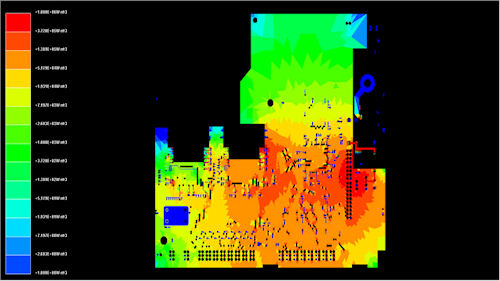Editor’s Pick: Electromagnetic Suite Simulates PCB and IC Designs

This ANSYS SIwave-DC screen image depicts a DC voltage drop analysis. Image courtesy of ANSYS, Inc.
Latest News
March 26, 2014
 Dear Desktop Engineering Reader:
Dear Desktop Engineering Reader:
 The goal of every design project is to get it right the first time—“first-pass success” in hipster MBA-tainted lingo. One key to first-pass success is to analyze and verify the accuracy of your design six ways to Sunday and maybe add in a little double overtime too. But intense competition, fewer resources, minimal physical prototyping and extremely tight deadlines have shortened development cycles, increasing the pressure on you to get it right first try. Today’s Pick of the Week looks at a suite of electromagnetic (EM) simulation software from ANSYS called SIwave. It might just be the thing to help designers of high-speed printed circuit boards (PCB) and integrated circuit (IC) packages get it right the first time within their timelines.
The goal of every design project is to get it right the first time—“first-pass success” in hipster MBA-tainted lingo. One key to first-pass success is to analyze and verify the accuracy of your design six ways to Sunday and maybe add in a little double overtime too. But intense competition, fewer resources, minimal physical prototyping and extremely tight deadlines have shortened development cycles, increasing the pressure on you to get it right first try. Today’s Pick of the Week looks at a suite of electromagnetic (EM) simulation software from ANSYS called SIwave. It might just be the thing to help designers of high-speed printed circuit boards (PCB) and integrated circuit (IC) packages get it right the first time within their timelines.
The sketch on ANSYS SIwave is that it’s a 3D platform for power integrity, signal integrity and EMI (electromagnetic interference) analysis of electronic packages and PCBs. ANSYS says that the SIwave suite helps you quickly identify potential power and signal integrity problems. The suite deploys a single interface across its many capabilities, which should make it easier to access tools and more flexible to work with.
SIwave is intended to help you evaluate an entire design from package to board, including the coupling effects between traces, packages and boards. Bi-directional links with ANSYS Icepak and ANSYS Mechanical toolsets help you predict temperature rise, thermal induced stress and structural integrity. You can export SIwave results to SPICE-compatible tools for time- and frequency-domain analysis. The suite is tuned for simulation and high-performance computing. The bottom line is that SIwave can help you identify and resolve signal- and power-integrity problems in your IC and PCB designs before you get down to expensive hardware prototyping.
The core of the SIwave suite is a hybrid field finite element EM solver engine that provides frequency and time-domain analyses using your IC or PCB design’s geometry. SIwave directly imports layout data from major ECAD packages outfits like Mentor Graphics and Zuken, meaning that SIwave extracts frequency-dependent circuit models of signal nets and power distribution networks with the physical dimensions and characteristics of your design.
ANSYS SIwave comes in three flavors: SIwave-DC, SIwave-PI and SIwave. The SIwave-DC product is for the DC (direct current) analysis of low-voltage, high-current PCB and IC packages and enables engineers to assess critical end-to-end voltage margins for reliable power delivery. SIwave-PI builds off SIwave-DC and adds AC (alternating current) analysis features for modeling power delivery networks and noise propagation on PCBs.
ANSYS SIwave has all the functionality of SIwave-DC and SIwave-PI plus a time-domain circuit simulation engine for end-to-end signal integrity design and compliance. SIwave also includes common Input/Output Buffer Information Specification (IBIS) analyses, which provides virtual compliance competence.
You can learn more about the SIwave suite from the links at the end of today’s Pick of the Week write-up. Jump to “the features of each ANSYS SIwave product” link to learn more about each individual SIwave product. However, the mother lode of in-depth details resides on the ANSYS SIwave page linked at the immediate end of today’s Pick of the Week write-up.
When you get there, first scroll down to see a quick list of competencies in each version of SIwave then make sure to sign up and download the white paper “From Signal Integrity to Product Integrity.” It’s nine pages of why minimizing EMI and ensuring integrity is so important to current and future product development. You also have seven on-demand video demos (ranging in size from about four minutes to over 15) and six tech briefs to investigate. If you have the time (43 minutes), check out the webinar on joule heating simulation using SIwave-ANSYS Icepak connectivity. It’s pretty good.
Thanks, Pal. — Lockwood
Anthony J. Lockwood
Editor at Large, Desktop Engineering
Read today’s pick of the week write-up.
This is sponsored content. Click here to see how it works.
Subscribe to our FREE magazine, FREE email newsletters or both!
Latest News
About the Author
Anthony J. Lockwood is Digital Engineering’s founding editor. He is now retired. Contact him via [email protected].
Follow DE





